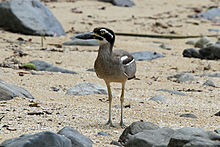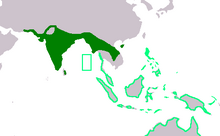| Beach stone-curlew | |
|---|---|

| |
| Scientific classification | |
| Domain: | Eukaryota |
| Kingdom: | Animalia |
| Phylum: | Chordata |
| Class: | Aves |
| Order: | Charadriiformes |
| Family: | Burhinidae |
| Genus: | Esacus |
| Species: | E. magnirostris
|
| Binomial name | |
| Esacus magnirostris (Vieillot, 1818)
| |

| |
E. magnirostris range E. recurvirostris range
| |
| Synonyms | |
|
Esacus neglectus | |
The beach stone-curlew (Esacus magnirostris) also known as beach thick-knee is a large, ground-dwelling bird that occurs in Australasia, the islands of South-east Asia. At 55 cm (22 in) and 1 kg (2.2 lb), it is one of the world's largest shorebirds.
It is less strictly nocturnal than most stone-curlews, and can sometimes be seen foraging by daylight, moving slowly and deliberately, with occasional short runs. It tends to be wary and fly off into the distance ahead of the observer, employing slow, rather stiff wingbeats..
The beach stone-curlew is classified as Near Threatened on the IUCN Red List of Threatened Species. In New South Wales it is listed as critically endangered.[2]
- ^ BirdLife International (2016). "Esacus magnirostris". IUCN Red List of Threatened Species. 2016: e.T22728621A94992570. doi:10.2305/IUCN.UK.2016-3.RLTS.T22728621A94992570.en. Retrieved 12 November 2021.
- ^ "Esacus magnirostris — Beach Stone-curlew". Species Profile and Threats Database.
